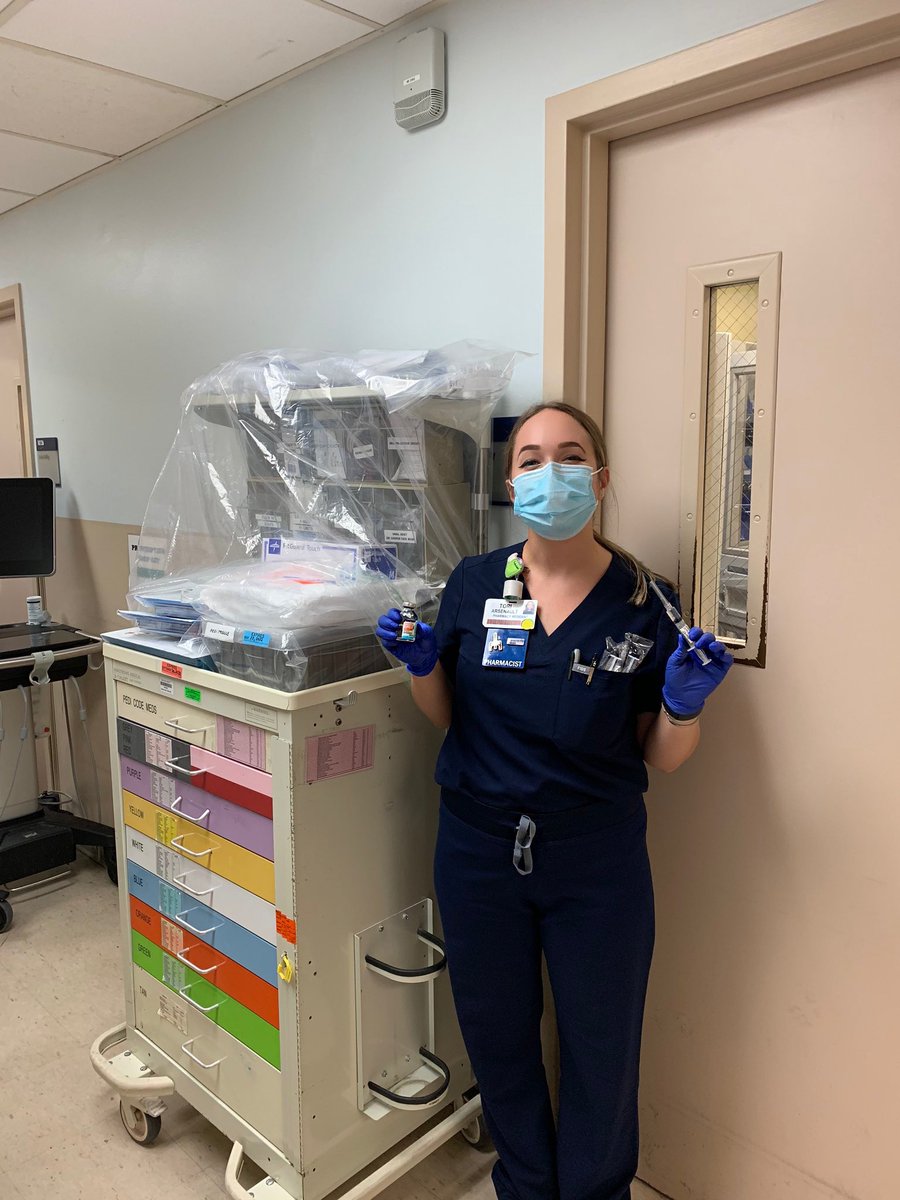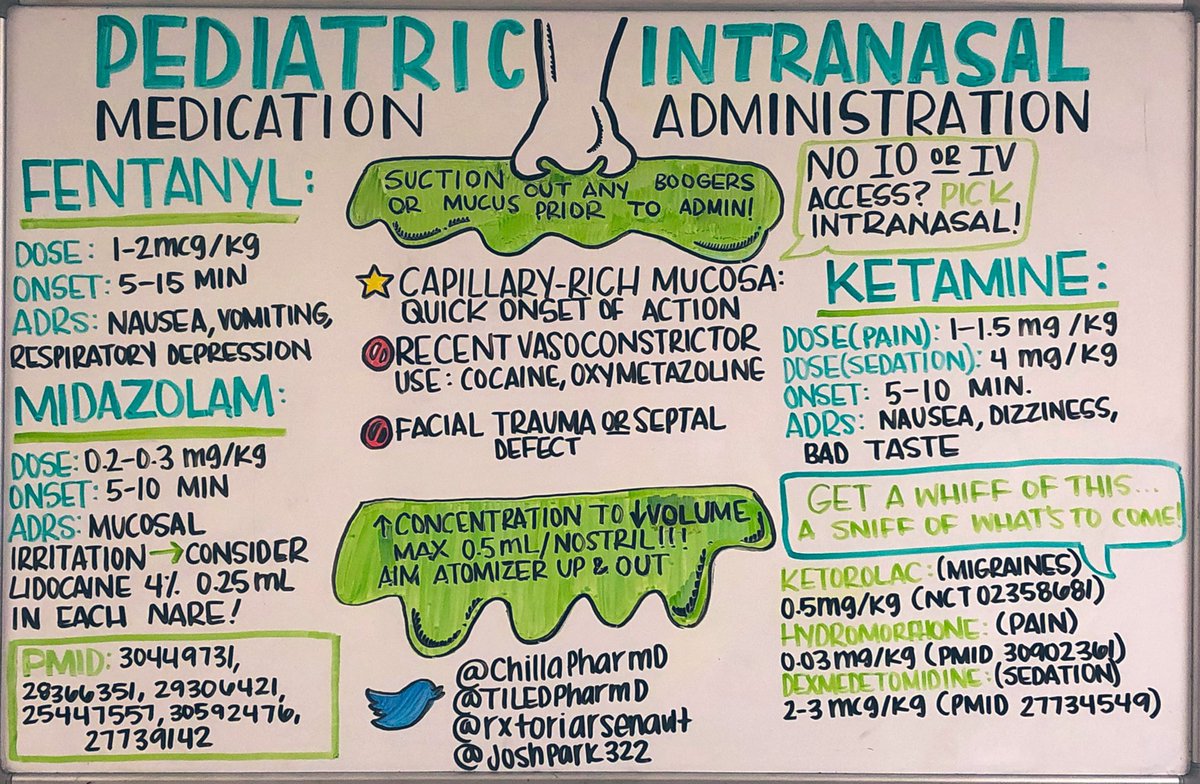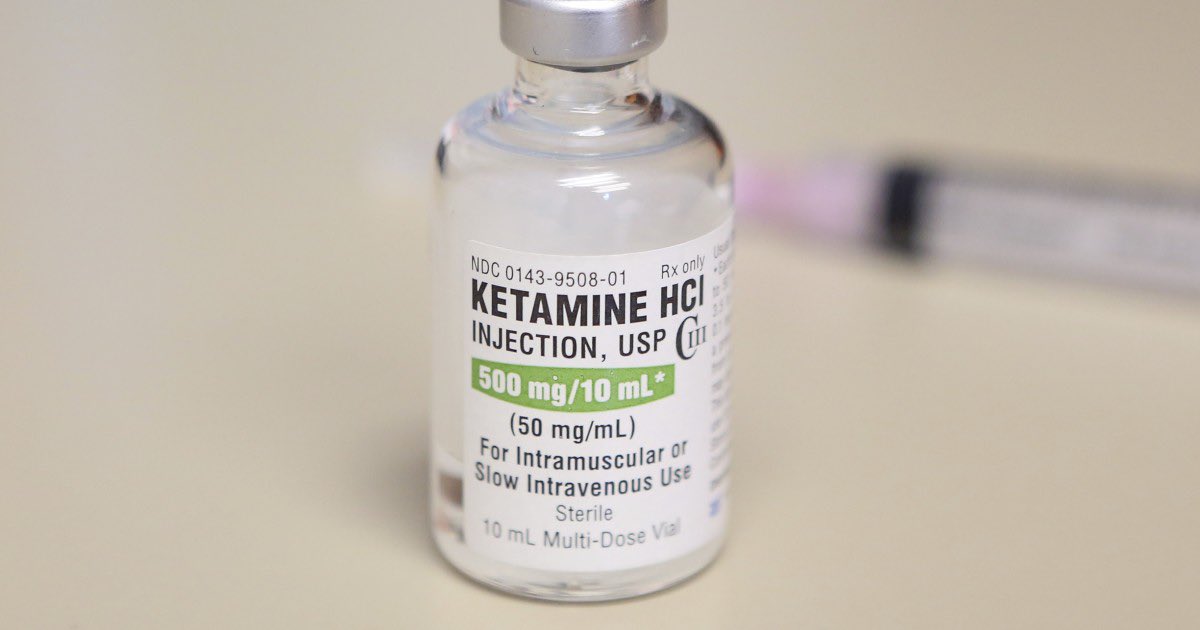TIL: a mini  https://abs.twimg.com/emoji/v2/... draggable="false" alt="🧵" title="Thread" aria-label="Emoji: Thread"> on one of my FAVORITE
https://abs.twimg.com/emoji/v2/... draggable="false" alt="🧵" title="Thread" aria-label="Emoji: Thread"> on one of my FAVORITE  https://abs.twimg.com/emoji/v2/... draggable="false" alt="💉" title="Spritze" aria-label="Emoji: Spritze">s used in the
https://abs.twimg.com/emoji/v2/... draggable="false" alt="💉" title="Spritze" aria-label="Emoji: Spritze">s used in the  https://abs.twimg.com/emoji/v2/... draggable="false" alt="🏥" title="Krankenhaus" aria-label="Emoji: Krankenhaus">...KETAMINE! Ketamine is an NMDA antagonist that can be used for pediatric sedation. Ketamine produces a dissociative state while also having analgesic properties! Here’s a picture of me beaming before procedural sedation!
https://abs.twimg.com/emoji/v2/... draggable="false" alt="🏥" title="Krankenhaus" aria-label="Emoji: Krankenhaus">...KETAMINE! Ketamine is an NMDA antagonist that can be used for pediatric sedation. Ketamine produces a dissociative state while also having analgesic properties! Here’s a picture of me beaming before procedural sedation!
In our pediatric population  https://abs.twimg.com/emoji/v2/... draggable="false" alt="🧸" title="Teddy bear" aria-label="Emoji: Teddy bear">, 1 mg/kg can be administered IV followed by 0.5 mg/kg resides for adequate sedation during a procedure
https://abs.twimg.com/emoji/v2/... draggable="false" alt="🧸" title="Teddy bear" aria-label="Emoji: Teddy bear">, 1 mg/kg can be administered IV followed by 0.5 mg/kg resides for adequate sedation during a procedure  https://abs.twimg.com/emoji/v2/... draggable="false" alt="💉" title="Spritze" aria-label="Emoji: Spritze">. No IV access? No PROBLEM! Ketamine can be given in many other routes...
https://abs.twimg.com/emoji/v2/... draggable="false" alt="💉" title="Spritze" aria-label="Emoji: Spritze">. No IV access? No PROBLEM! Ketamine can be given in many other routes...
For pain and sedation we can utilize IN  https://abs.twimg.com/emoji/v2/... draggable="false" alt="👃" title="Nase" aria-label="Emoji: Nase"> ketamine! 1 mg/kg for pain or 4 mg/kg IN for sedation has been utilized. however, only 0.5 mL/nostril should be given for optimal absorption. Did you see our recent
https://abs.twimg.com/emoji/v2/... draggable="false" alt="👃" title="Nase" aria-label="Emoji: Nase"> ketamine! 1 mg/kg for pain or 4 mg/kg IN for sedation has been utilized. however, only 0.5 mL/nostril should be given for optimal absorption. Did you see our recent  https://abs.twimg.com/emoji/v2/... draggable="false" alt="🦠" title="Microbe" aria-label="Emoji: Microbe">”Boogie Board”
https://abs.twimg.com/emoji/v2/... draggable="false" alt="🦠" title="Microbe" aria-label="Emoji: Microbe">”Boogie Board” https://abs.twimg.com/emoji/v2/... draggable="false" alt="🦠" title="Microbe" aria-label="Emoji: Microbe"> on pediatric IN medication administration?
https://abs.twimg.com/emoji/v2/... draggable="false" alt="🦠" title="Microbe" aria-label="Emoji: Microbe"> on pediatric IN medication administration?
If IV https://abs.twimg.com/emoji/v2/... draggable="false" alt="💉" title="Spritze" aria-label="Emoji: Spritze">or IN
https://abs.twimg.com/emoji/v2/... draggable="false" alt="💉" title="Spritze" aria-label="Emoji: Spritze">or IN https://abs.twimg.com/emoji/v2/... draggable="false" alt="👃" title="Nase" aria-label="Emoji: Nase"> isn’t optimal for your patient... Don’t fret! Ketamine can be given IM! Most commonly a dose of 4 mg/kg IM has been utilized for sedation!
https://abs.twimg.com/emoji/v2/... draggable="false" alt="👃" title="Nase" aria-label="Emoji: Nase"> isn’t optimal for your patient... Don’t fret! Ketamine can be given IM! Most commonly a dose of 4 mg/kg IM has been utilized for sedation!  https://abs.twimg.com/emoji/v2/... draggable="false" alt="😴" title="Schlafendes Gesicht" aria-label="Emoji: Schlafendes Gesicht">
https://abs.twimg.com/emoji/v2/... draggable="false" alt="😴" title="Schlafendes Gesicht" aria-label="Emoji: Schlafendes Gesicht">  https://abs.twimg.com/emoji/v2/... draggable="false" alt="💤" title="Schlafsymbol" aria-label="Emoji: Schlafsymbol">
https://abs.twimg.com/emoji/v2/... draggable="false" alt="💤" title="Schlafsymbol" aria-label="Emoji: Schlafsymbol">
You may have heard of an  https://abs.twimg.com/emoji/v2/... draggable="false" alt="🤬" title="Gesicht mit Symbolen über dem Mund" aria-label="Emoji: Gesicht mit Symbolen über dem Mund">
https://abs.twimg.com/emoji/v2/... draggable="false" alt="🤬" title="Gesicht mit Symbolen über dem Mund" aria-label="Emoji: Gesicht mit Symbolen über dem Mund"> https://abs.twimg.com/emoji/v2/... draggable="false" alt="🤯" title="Explodierender Kopf" aria-label="Emoji: Explodierender Kopf">
https://abs.twimg.com/emoji/v2/... draggable="false" alt="🤯" title="Explodierender Kopf" aria-label="Emoji: Explodierender Kopf"> https://abs.twimg.com/emoji/v2/... draggable="false" alt="😳" title="Errötetes Gesicht" aria-label="Emoji: Errötetes Gesicht">emergence reaction that occurs with the use of ketamine! Dim lighting,
https://abs.twimg.com/emoji/v2/... draggable="false" alt="😳" title="Errötetes Gesicht" aria-label="Emoji: Errötetes Gesicht">emergence reaction that occurs with the use of ketamine! Dim lighting,  https://abs.twimg.com/emoji/v2/... draggable="false" alt="🤫" title="Schh!-Gesicht" aria-label="Emoji: Schh!-Gesicht"> quiet location, and having your patient “think
https://abs.twimg.com/emoji/v2/... draggable="false" alt="🤫" title="Schh!-Gesicht" aria-label="Emoji: Schh!-Gesicht"> quiet location, and having your patient “think  https://abs.twimg.com/emoji/v2/... draggable="false" alt="😊" title="Lächelndes Gesicht mit lächelnden Augen" aria-label="Emoji: Lächelndes Gesicht mit lächelnden Augen">HAPPY
https://abs.twimg.com/emoji/v2/... draggable="false" alt="😊" title="Lächelndes Gesicht mit lächelnden Augen" aria-label="Emoji: Lächelndes Gesicht mit lächelnden Augen">HAPPY https://abs.twimg.com/emoji/v2/... draggable="false" alt="😊" title="Lächelndes Gesicht mit lächelnden Augen" aria-label="Emoji: Lächelndes Gesicht mit lächelnden Augen"> thoughts” can all help mitigate this phenomena. Its important to set the tone for a positive experience....
https://abs.twimg.com/emoji/v2/... draggable="false" alt="😊" title="Lächelndes Gesicht mit lächelnden Augen" aria-label="Emoji: Lächelndes Gesicht mit lächelnden Augen"> thoughts” can all help mitigate this phenomena. Its important to set the tone for a positive experience....
Talking about a show or something your patient really enjoys seems to be beneficial in my experience! Even pulling out your phone and youtubing Spongebob  https://abs.twimg.com/emoji/v2/... draggable="false" alt="🧽" title="Sponge" aria-label="Emoji: Sponge"> or baby
https://abs.twimg.com/emoji/v2/... draggable="false" alt="🧽" title="Sponge" aria-label="Emoji: Sponge"> or baby  https://abs.twimg.com/emoji/v2/... draggable="false" alt="🦈" title="Hai" aria-label="Emoji: Hai"> has done wonders for calming our
https://abs.twimg.com/emoji/v2/... draggable="false" alt="🦈" title="Hai" aria-label="Emoji: Hai"> has done wonders for calming our  https://abs.twimg.com/emoji/v2/... draggable="false" alt="😭" title="Laut schreiendes Gesicht" aria-label="Emoji: Laut schreiendes Gesicht"> pediatric friends prior to induction
https://abs.twimg.com/emoji/v2/... draggable="false" alt="😭" title="Laut schreiendes Gesicht" aria-label="Emoji: Laut schreiendes Gesicht"> pediatric friends prior to induction https://abs.twimg.com/emoji/v2/... draggable="false" alt="💕" title="Zwei Herzen" aria-label="Emoji: Zwei Herzen">
https://abs.twimg.com/emoji/v2/... draggable="false" alt="💕" title="Zwei Herzen" aria-label="Emoji: Zwei Herzen"> https://abs.twimg.com/emoji/v2/... draggable="false" alt="😂" title="Gesicht mit Freudentränen" aria-label="Emoji: Gesicht mit Freudentränen">
https://abs.twimg.com/emoji/v2/... draggable="false" alt="😂" title="Gesicht mit Freudentränen" aria-label="Emoji: Gesicht mit Freudentränen">
Historically, ketamine has been  https://abs.twimg.com/emoji/v2/... draggable="false" alt="🚫" title=""Betreten verboten!"-Zeichen" aria-label="Emoji: "Betreten verboten!"-Zeichen">avoided
https://abs.twimg.com/emoji/v2/... draggable="false" alt="🚫" title=""Betreten verboten!"-Zeichen" aria-label="Emoji: "Betreten verboten!"-Zeichen">avoided https://abs.twimg.com/emoji/v2/... draggable="false" alt="🚫" title=""Betreten verboten!"-Zeichen" aria-label="Emoji: "Betreten verboten!"-Zeichen">in adults because of this emergence reaction (but can be mitigated w/ BDZ). Pediatric patients are RESILIENT
https://abs.twimg.com/emoji/v2/... draggable="false" alt="🚫" title=""Betreten verboten!"-Zeichen" aria-label="Emoji: "Betreten verboten!"-Zeichen">in adults because of this emergence reaction (but can be mitigated w/ BDZ). Pediatric patients are RESILIENT  https://abs.twimg.com/emoji/v2/... draggable="false" alt="🌟" title="Leuchtender Stern" aria-label="Emoji: Leuchtender Stern"> & it appears that this reaction phenomena is VERY rare in those < 10 years old during the recovery phase
https://abs.twimg.com/emoji/v2/... draggable="false" alt="🌟" title="Leuchtender Stern" aria-label="Emoji: Leuchtender Stern"> & it appears that this reaction phenomena is VERY rare in those < 10 years old during the recovery phase https://abs.twimg.com/emoji/v2/... draggable="false" alt="‼️" title="Doppeltes Ausrufezeichen" aria-label="Emoji: Doppeltes Ausrufezeichen">
https://abs.twimg.com/emoji/v2/... draggable="false" alt="‼️" title="Doppeltes Ausrufezeichen" aria-label="Emoji: Doppeltes Ausrufezeichen">
Another reason why I  https://abs.twimg.com/emoji/v2/... draggable="false" alt="❤️" title="Rotes Herz" aria-label="Emoji: Rotes Herz"> ketamine is because our is an excellent option for sedation/induction in patients with asthma
https://abs.twimg.com/emoji/v2/... draggable="false" alt="❤️" title="Rotes Herz" aria-label="Emoji: Rotes Herz"> ketamine is because our is an excellent option for sedation/induction in patients with asthma  https://abs.twimg.com/emoji/v2/... draggable="false" alt="💨" title="Staubwolke" aria-label="Emoji: Staubwolke"> as it
https://abs.twimg.com/emoji/v2/... draggable="false" alt="💨" title="Staubwolke" aria-label="Emoji: Staubwolke"> as it  https://abs.twimg.com/emoji/v2/... draggable="false" alt="⬇️" title="Pfeil nach unten" aria-label="Emoji: Pfeil nach unten"> bronchospasm. this is caused by
https://abs.twimg.com/emoji/v2/... draggable="false" alt="⬇️" title="Pfeil nach unten" aria-label="Emoji: Pfeil nach unten"> bronchospasm. this is caused by  https://abs.twimg.com/emoji/v2/... draggable="false" alt="⬆️" title="Pfeil nach oben" aria-label="Emoji: Pfeil nach oben"> in catecholamines, direct smooth muscle dilation and
https://abs.twimg.com/emoji/v2/... draggable="false" alt="⬆️" title="Pfeil nach oben" aria-label="Emoji: Pfeil nach oben"> in catecholamines, direct smooth muscle dilation and  https://abs.twimg.com/emoji/v2/... draggable="false" alt="🚫" title=""Betreten verboten!"-Zeichen" aria-label="Emoji: "Betreten verboten!"-Zeichen"> of vagal outflow.
https://abs.twimg.com/emoji/v2/... draggable="false" alt="🚫" title=""Betreten verboten!"-Zeichen" aria-label="Emoji: "Betreten verboten!"-Zeichen"> of vagal outflow.
Some patients may experience nausea, pretreating with ondansetron prior to ketamine administration can  https://abs.twimg.com/emoji/v2/... draggable="false" alt="⬇️" title="Pfeil nach unten" aria-label="Emoji: Pfeil nach unten">
https://abs.twimg.com/emoji/v2/... draggable="false" alt="⬇️" title="Pfeil nach unten" aria-label="Emoji: Pfeil nach unten"> https://abs.twimg.com/emoji/v2/... draggable="false" alt="🤢" title="Angewidertes Gesicht" aria-label="Emoji: Angewidertes Gesicht">
https://abs.twimg.com/emoji/v2/... draggable="false" alt="🤢" title="Angewidertes Gesicht" aria-label="Emoji: Angewidertes Gesicht"> https://abs.twimg.com/emoji/v2/... draggable="false" alt="🤮" title="Spuckendes Gesicht" aria-label="Emoji: Spuckendes Gesicht"> in our pediatric friends. We should also monitor for laryngospasm (although rare), increased secretions and
https://abs.twimg.com/emoji/v2/... draggable="false" alt="🤮" title="Spuckendes Gesicht" aria-label="Emoji: Spuckendes Gesicht"> in our pediatric friends. We should also monitor for laryngospasm (although rare), increased secretions and  https://abs.twimg.com/emoji/v2/... draggable="false" alt="⬆️" title="Pfeil nach oben" aria-label="Emoji: Pfeil nach oben">
https://abs.twimg.com/emoji/v2/... draggable="false" alt="⬆️" title="Pfeil nach oben" aria-label="Emoji: Pfeil nach oben"> https://abs.twimg.com/emoji/v2/... draggable="false" alt="❤️" title="Rotes Herz" aria-label="Emoji: Rotes Herz">HR.
https://abs.twimg.com/emoji/v2/... draggable="false" alt="❤️" title="Rotes Herz" aria-label="Emoji: Rotes Herz">HR.
Some pts experience nystagmus  https://abs.twimg.com/emoji/v2/... draggable="false" alt="👁" title="Auge" aria-label="Emoji: Auge"> or ataxia, but those are usually self limiting!
https://abs.twimg.com/emoji/v2/... draggable="false" alt="👁" title="Auge" aria-label="Emoji: Auge"> or ataxia, but those are usually self limiting!
I hope that this thread https://abs.twimg.com/emoji/v2/... draggable="false" alt="🧵" title="Thread" aria-label="Emoji: Thread"> helps you appreciate ketamine and all it’s wonder, especially in the ED setting
https://abs.twimg.com/emoji/v2/... draggable="false" alt="🧵" title="Thread" aria-label="Emoji: Thread"> helps you appreciate ketamine and all it’s wonder, especially in the ED setting https://abs.twimg.com/emoji/v2/... draggable="false" alt="💉" title="Spritze" aria-label="Emoji: Spritze">
https://abs.twimg.com/emoji/v2/... draggable="false" alt="💉" title="Spritze" aria-label="Emoji: Spritze"> https://abs.twimg.com/emoji/v2/... draggable="false" alt="💤" title="Schlafsymbol" aria-label="Emoji: Schlafsymbol">!
https://abs.twimg.com/emoji/v2/... draggable="false" alt="💤" title="Schlafsymbol" aria-label="Emoji: Schlafsymbol">!
I hope that this thread
PMID: 15107362, 25447557, 2203290
-Tori

 Read on Twitter
Read on Twitter on one of my FAVORITE https://abs.twimg.com/emoji/v2/... draggable="false" alt="💉" title="Spritze" aria-label="Emoji: Spritze">s used in the https://abs.twimg.com/emoji/v2/... draggable="false" alt="🏥" title="Krankenhaus" aria-label="Emoji: Krankenhaus">...KETAMINE! Ketamine is an NMDA antagonist that can be used for pediatric sedation. Ketamine produces a dissociative state while also having analgesic properties! Here’s a picture of me beaming before procedural sedation!" title="TIL: a mini https://abs.twimg.com/emoji/v2/... draggable="false" alt="🧵" title="Thread" aria-label="Emoji: Thread"> on one of my FAVORITE https://abs.twimg.com/emoji/v2/... draggable="false" alt="💉" title="Spritze" aria-label="Emoji: Spritze">s used in the https://abs.twimg.com/emoji/v2/... draggable="false" alt="🏥" title="Krankenhaus" aria-label="Emoji: Krankenhaus">...KETAMINE! Ketamine is an NMDA antagonist that can be used for pediatric sedation. Ketamine produces a dissociative state while also having analgesic properties! Here’s a picture of me beaming before procedural sedation!" class="img-responsive" style="max-width:100%;"/>
on one of my FAVORITE https://abs.twimg.com/emoji/v2/... draggable="false" alt="💉" title="Spritze" aria-label="Emoji: Spritze">s used in the https://abs.twimg.com/emoji/v2/... draggable="false" alt="🏥" title="Krankenhaus" aria-label="Emoji: Krankenhaus">...KETAMINE! Ketamine is an NMDA antagonist that can be used for pediatric sedation. Ketamine produces a dissociative state while also having analgesic properties! Here’s a picture of me beaming before procedural sedation!" title="TIL: a mini https://abs.twimg.com/emoji/v2/... draggable="false" alt="🧵" title="Thread" aria-label="Emoji: Thread"> on one of my FAVORITE https://abs.twimg.com/emoji/v2/... draggable="false" alt="💉" title="Spritze" aria-label="Emoji: Spritze">s used in the https://abs.twimg.com/emoji/v2/... draggable="false" alt="🏥" title="Krankenhaus" aria-label="Emoji: Krankenhaus">...KETAMINE! Ketamine is an NMDA antagonist that can be used for pediatric sedation. Ketamine produces a dissociative state while also having analgesic properties! Here’s a picture of me beaming before procedural sedation!" class="img-responsive" style="max-width:100%;"/>
 ketamine! 1 mg/kg for pain or 4 mg/kg IN for sedation has been utilized. however, only 0.5 mL/nostril should be given for optimal absorption. Did you see our recent https://abs.twimg.com/emoji/v2/... draggable="false" alt="🦠" title="Microbe" aria-label="Emoji: Microbe">”Boogie Board”https://abs.twimg.com/emoji/v2/... draggable="false" alt="🦠" title="Microbe" aria-label="Emoji: Microbe"> on pediatric IN medication administration?" title="For pain and sedation we can utilize IN https://abs.twimg.com/emoji/v2/... draggable="false" alt="👃" title="Nase" aria-label="Emoji: Nase"> ketamine! 1 mg/kg for pain or 4 mg/kg IN for sedation has been utilized. however, only 0.5 mL/nostril should be given for optimal absorption. Did you see our recent https://abs.twimg.com/emoji/v2/... draggable="false" alt="🦠" title="Microbe" aria-label="Emoji: Microbe">”Boogie Board”https://abs.twimg.com/emoji/v2/... draggable="false" alt="🦠" title="Microbe" aria-label="Emoji: Microbe"> on pediatric IN medication administration?" class="img-responsive" style="max-width:100%;"/>
ketamine! 1 mg/kg for pain or 4 mg/kg IN for sedation has been utilized. however, only 0.5 mL/nostril should be given for optimal absorption. Did you see our recent https://abs.twimg.com/emoji/v2/... draggable="false" alt="🦠" title="Microbe" aria-label="Emoji: Microbe">”Boogie Board”https://abs.twimg.com/emoji/v2/... draggable="false" alt="🦠" title="Microbe" aria-label="Emoji: Microbe"> on pediatric IN medication administration?" title="For pain and sedation we can utilize IN https://abs.twimg.com/emoji/v2/... draggable="false" alt="👃" title="Nase" aria-label="Emoji: Nase"> ketamine! 1 mg/kg for pain or 4 mg/kg IN for sedation has been utilized. however, only 0.5 mL/nostril should be given for optimal absorption. Did you see our recent https://abs.twimg.com/emoji/v2/... draggable="false" alt="🦠" title="Microbe" aria-label="Emoji: Microbe">”Boogie Board”https://abs.twimg.com/emoji/v2/... draggable="false" alt="🦠" title="Microbe" aria-label="Emoji: Microbe"> on pediatric IN medication administration?" class="img-responsive" style="max-width:100%;"/>
 ketamine is because our is an excellent option for sedation/induction in patients with asthma https://abs.twimg.com/emoji/v2/... draggable="false" alt="💨" title="Staubwolke" aria-label="Emoji: Staubwolke"> as it https://abs.twimg.com/emoji/v2/... draggable="false" alt="⬇️" title="Pfeil nach unten" aria-label="Emoji: Pfeil nach unten"> bronchospasm. this is caused by https://abs.twimg.com/emoji/v2/... draggable="false" alt="⬆️" title="Pfeil nach oben" aria-label="Emoji: Pfeil nach oben"> in catecholamines, direct smooth muscle dilation and https://abs.twimg.com/emoji/v2/... draggable="false" alt="🚫" title=""Betreten verboten!"-Zeichen" aria-label="Emoji: "Betreten verboten!"-Zeichen"> of vagal outflow." title="Another reason why I https://abs.twimg.com/emoji/v2/... draggable="false" alt="❤️" title="Rotes Herz" aria-label="Emoji: Rotes Herz"> ketamine is because our is an excellent option for sedation/induction in patients with asthma https://abs.twimg.com/emoji/v2/... draggable="false" alt="💨" title="Staubwolke" aria-label="Emoji: Staubwolke"> as it https://abs.twimg.com/emoji/v2/... draggable="false" alt="⬇️" title="Pfeil nach unten" aria-label="Emoji: Pfeil nach unten"> bronchospasm. this is caused by https://abs.twimg.com/emoji/v2/... draggable="false" alt="⬆️" title="Pfeil nach oben" aria-label="Emoji: Pfeil nach oben"> in catecholamines, direct smooth muscle dilation and https://abs.twimg.com/emoji/v2/... draggable="false" alt="🚫" title=""Betreten verboten!"-Zeichen" aria-label="Emoji: "Betreten verboten!"-Zeichen"> of vagal outflow." class="img-responsive" style="max-width:100%;"/>
ketamine is because our is an excellent option for sedation/induction in patients with asthma https://abs.twimg.com/emoji/v2/... draggable="false" alt="💨" title="Staubwolke" aria-label="Emoji: Staubwolke"> as it https://abs.twimg.com/emoji/v2/... draggable="false" alt="⬇️" title="Pfeil nach unten" aria-label="Emoji: Pfeil nach unten"> bronchospasm. this is caused by https://abs.twimg.com/emoji/v2/... draggable="false" alt="⬆️" title="Pfeil nach oben" aria-label="Emoji: Pfeil nach oben"> in catecholamines, direct smooth muscle dilation and https://abs.twimg.com/emoji/v2/... draggable="false" alt="🚫" title=""Betreten verboten!"-Zeichen" aria-label="Emoji: "Betreten verboten!"-Zeichen"> of vagal outflow." title="Another reason why I https://abs.twimg.com/emoji/v2/... draggable="false" alt="❤️" title="Rotes Herz" aria-label="Emoji: Rotes Herz"> ketamine is because our is an excellent option for sedation/induction in patients with asthma https://abs.twimg.com/emoji/v2/... draggable="false" alt="💨" title="Staubwolke" aria-label="Emoji: Staubwolke"> as it https://abs.twimg.com/emoji/v2/... draggable="false" alt="⬇️" title="Pfeil nach unten" aria-label="Emoji: Pfeil nach unten"> bronchospasm. this is caused by https://abs.twimg.com/emoji/v2/... draggable="false" alt="⬆️" title="Pfeil nach oben" aria-label="Emoji: Pfeil nach oben"> in catecholamines, direct smooth muscle dilation and https://abs.twimg.com/emoji/v2/... draggable="false" alt="🚫" title=""Betreten verboten!"-Zeichen" aria-label="Emoji: "Betreten verboten!"-Zeichen"> of vagal outflow." class="img-responsive" style="max-width:100%;"/>


